[Editor’s Note: Near the outset of this project, on June 26, 2014, I published photographer and historian Rob McElroy’s analysis of the examples of Robert Capa’s “ruined” D-Day negatives presented in a 70th-anniversary video commissioned by TIME, Inc. from Magnum in Motion, the media division of Magnum Photos, the picture agency founded by Capa and his colleagues in 1947.
 McElroy’s examination proved conclusively that those supposed examples of catastrophically damaged negatives constituted nothing more than digitally altered versions of Capa’s surviving D-Day negatives. In short, they were forgeries, created and published with the approval of the International Center of Photography (ICP), which authorized the use of Capa’s images in that video.
McElroy’s examination proved conclusively that those supposed examples of catastrophically damaged negatives constituted nothing more than digitally altered versions of Capa’s surviving D-Day negatives. In short, they were forgeries, created and published with the approval of the International Center of Photography (ICP), which authorized the use of Capa’s images in that video.
Publication of McElroy’s report — coupled with my filing of a formal complaint about this fraud with the Ethics Committee of the National Press Photographers Association (NPPA) — led to the re-editing of that video, with the faked negatives now clearly labeled as photo-illustrations.
 It also exemplified a long-term pattern of playing fast and loose with the truth about Capa’s actions on D-Day and the subsequent fate of his images — a pattern shared, either knowingly or osmotically, by a number of individuals and institutions for whom the promulgation of the Capa myth provides a variety of benefits.
It also exemplified a long-term pattern of playing fast and loose with the truth about Capa’s actions on D-Day and the subsequent fate of his images — a pattern shared, either knowingly or osmotically, by a number of individuals and institutions for whom the promulgation of the Capa myth provides a variety of benefits.
In the new article below McElroy turns his attention to a notable feature of Capa’s surviving D-Day negatives, demonstrating inarguably that what curators at ICP have claimed as evidence of that fabled darkroom disaster in fact signifies something entirely different. Part 1 appears below; click here for Part 2. — A. D. C.]
•
The Slipping Cassette:
Dispelling the Robert Capa Sliding-Emulsion Myth
by Rob McElroy
(Click on the illustrations to view larger versions.)
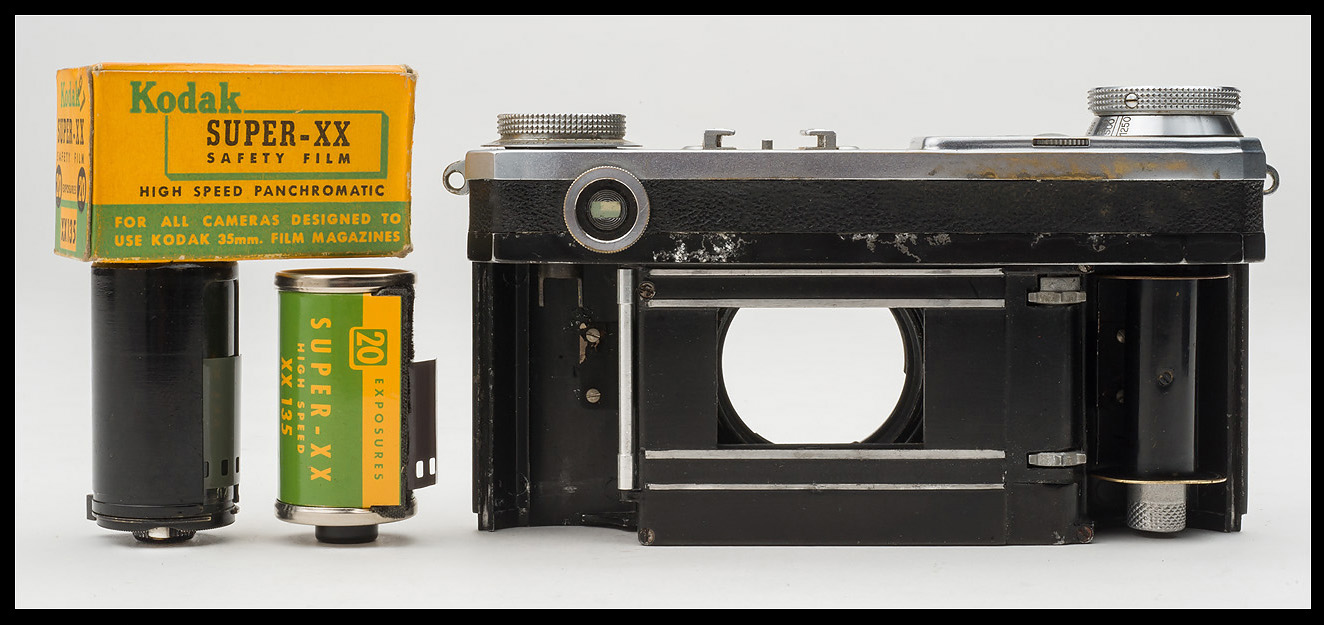
A Zeiss Ikon reloadable film cassette and a roll of Kodak Super-XX 35mm film sit next to a Contax II camera, the model used by Robert Capa on D-Day. (Note difference in height of cassettes.) Photo © 2015 by Rob McElroy.
Did the emulsion on photographer Robert Capa’s famous negatives from Omaha Beach on D-Day actually melt and slide over the film’s sprocket holes? That’s what the late Richard Whelan, authorized Capa biographer and former Capa Archive Curator at the International Center of Photography (ICP) would have us believe. His successor at ICP, Cynthia Young, has also perpetuated the story, without verifying whether the sliding-emulsion phenomenon was even probable. In truth, this unfounded myth is nothing more than a self-serving fabrication, with no basis in fact.
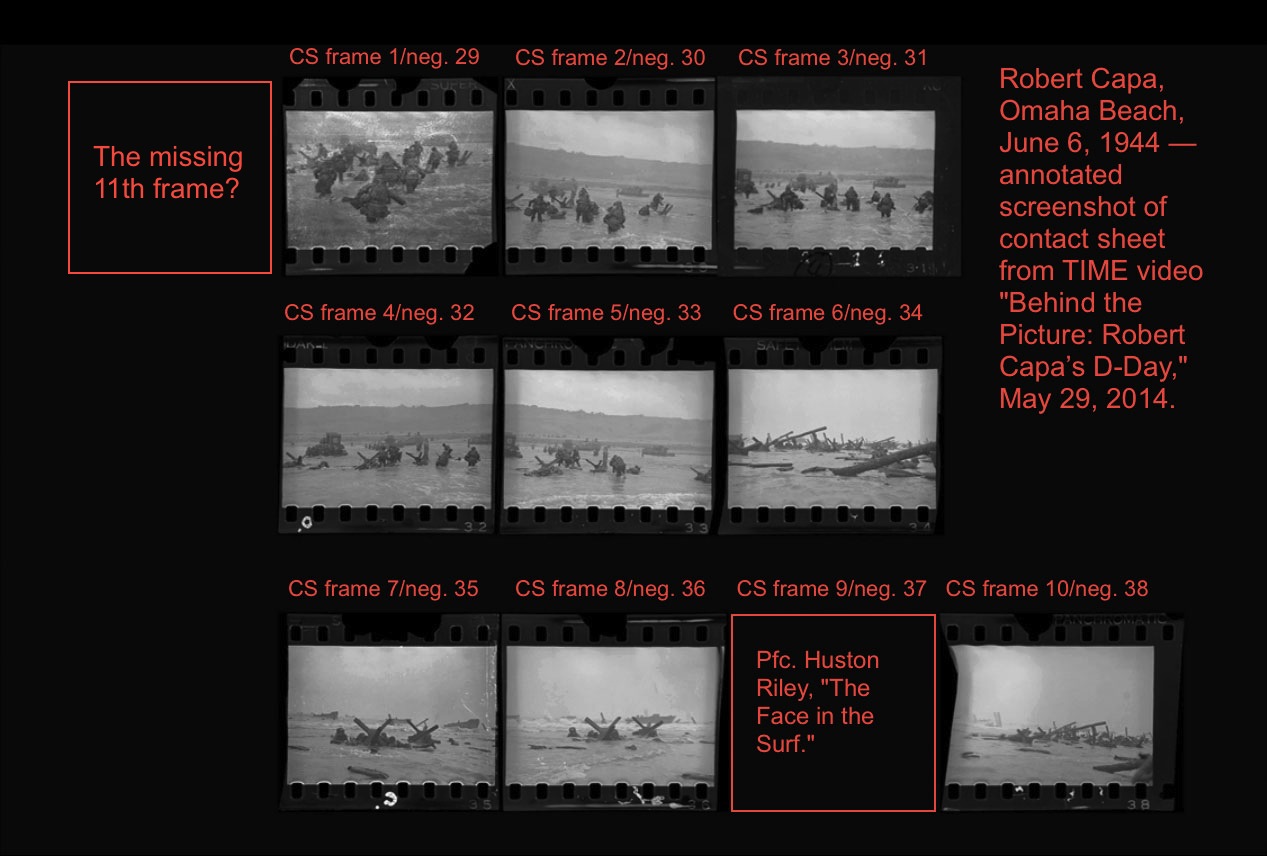
Robert Capa, D-Day images from Omaha Beach, contact sheet, screenshot from TIME video (May 29, 2014), annotated.
Whelan’s story misleads the public in much the same way as the creators of TIME magazine’s 2014 documentary video, “Behind the Picture: Robert Capa’s D-Day,” deliberately deceived viewers by fabricating fake negatives which purported to show the melted emulsion on Capa’s “ruined” negatives from that day. Only after I exposed their deception last year did TIME quickly backtrack and label their fraudulent negatives as “photo illustrations.”
For seven decades, the darkroom horror story, told and retold by LIFE picture editor John G. Morris, asserted that the emulsion on all of Capa’s four purported rolls of 35mm film from D-Day in June 1944 had melted in an overheated film-drying cabinet, ruining all but eleven images on one of the rolls. Miraculously, those eleven frames somehow survived the overheating, exhibiting no distortion or obvious ill effects whatsoever from the elevated temperature. Was it a miracle, or was it something else? The remaining three and two-thirds rolls of overheated negatives were then discarded, Morris said — and the melting-emulsion legend was born.
(Note: Morris has always claimed that eleven negatives had survived the darkroom disaster, but only ten negatives are actually known today, and one of them, Capa’s most famous image,” The Face in the Surf,” went missing many years ago, leaving only nine extant original negatives.)
This latest controversy concerns Capa’s handful of successful D-Day negatives, not the supposedly ruined and discarded ones. It was first brought to light by A. D. Coleman in the course of his ongoing investigation into the possibility that none of Capa’s D-Day film had been destroyed by overheating, and that the 70-year-old melting-emulsion story might simply be a ruse.
Whelan’s assertion that the heat-softened emulsion on the surviving ten negatives had somehow loosened from the base of the film and slid over the edge of the sprocket holes made its first appearance in the D-Day chapter of This Is War! Robert Capa at Work, the catalog for ICP’s 2007 exhibition, wherein Whelan wrote,
“Although eleven of the 35mm images were usable, they had not completely escaped being damaged. The emulsion on them had melted just enough so that it slid a bit over the surface of the film. Consequently, sprocket holes — which would normally punctuate the unexposed margin of the film — cut into the lower portion of the images themselves. Ironically, the blurring of the surviving images may actually have strengthened their dramatic impact, for it imbues them with an almost tangible sense of urgency and explosive reverberation.” (p. 239)
Coleman challenged the plausibility of Whelan’s sliding-emulsion narrative, arguing convincingly that it was as untenable a declaration as Morris’s melting-emulsion darkroom fable. In my opinion, this wasn’t an innocent confabulation by Whelan, but was instead a calculated deception intended to help validate the darkroom-disaster story about the “ruined” film that was supposedly thrown out. In other words, it was a ploy.
As Coleman points out, Whelan and Young worked closely on this exhibition and catalog. While doing so they also had access to all of Capa’s contact sheets, which are organized chronologically in three-ring binders at ICP. According to Coleman’s report, written after spending two days examining the primary materials in the Capa Archive at ICP, the majority of Capa’s contact sheets from his six months of war assignments in the first half of 1944 exhibit this same sprocket-hole intrusion problem, clearly visible to the naked eye.
Because so many additional rolls of Capa’s film exhibit the identical sprocket-hole phenomenon, Coleman asserts that Whelan and Young had to have known there was another explanation for it. As Coleman correctly concludes, “Inarguably, [the sprocket-hole issue] resulted not from some post-processing freak accident but from a minor mechanical malfunction of one of Capa’s two Contax 35mm cameras, affecting dozens if not hundreds of rolls of film.”
On ICP’s website in 2013, six years after publication of the This is War! exhibition catalog, in a statement bearing her byline and titled “The Story Behind Robert Capa’s Pictures of D-Day,” Young plagiarized Whelan’s sliding-emulsion chimera by repeating it verbatim, without attribution, while also promulgating Morris’s 70-year-old melting-emulsion fantasy.
If Whelan or Young had done their due diligence by consulting photography experts to learn why the image area of Capa’s negatives had encroached on the sprocket holes on one side of the film, they never would have floated such an easily disprovable theory in public. Now they both stand implicated in promoting this falsehood, and as Coleman wrote, “Alas for Whelan, and his reputation, this constitutes not just an error but a lie.”
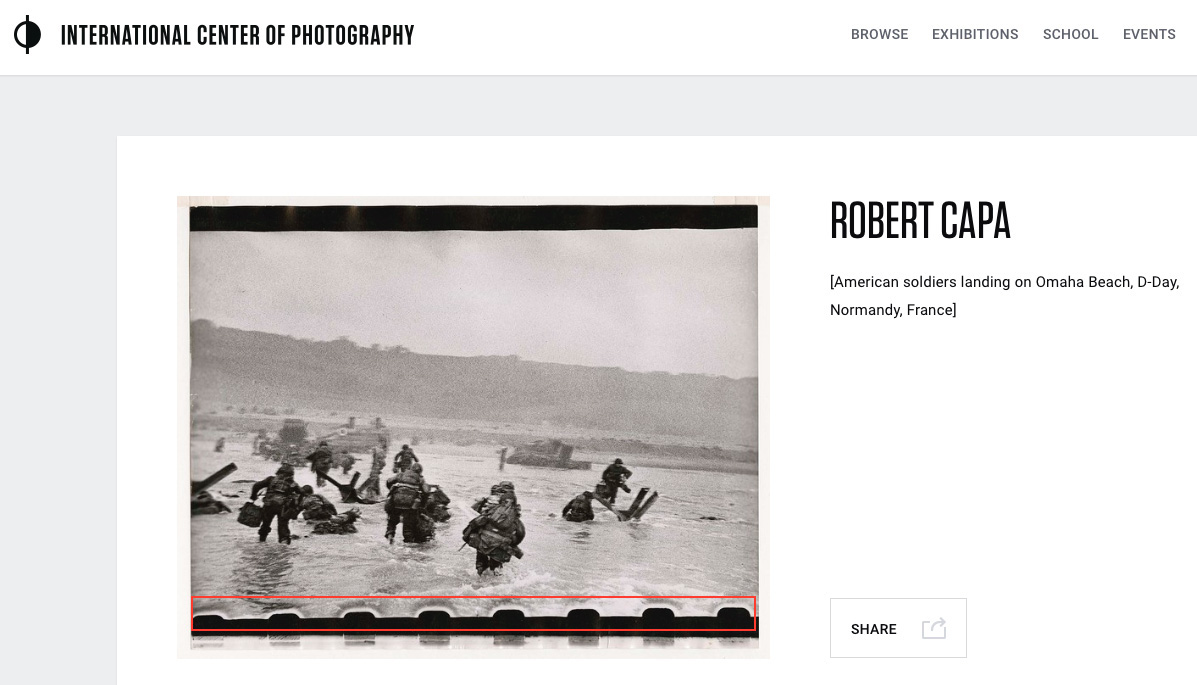
Screen shot of Capa D-Day contact print from ICP website, showing sprocket-hole intrusion (indicated in red).
The real reason the sprocket holes along one edge of Capa’s ten D-Day negatives became partially exposed is a logical and simple one. It had nothing to do with any supposed emulsion slide from when the film was processed and dried. Nor did it result from some defect in either of Capa’s Zeiss Ikon Contax II cameras, or improper film-loading. The cassettes containing the film caused the problem.
From the surviving negatives, we can tell that Capa used 36-exposure rolls of Kodak’s Super-XX b&w film on Omaha Beach on June 6, 1944. It turns out that the cassettes manufactured by Kodak were 2mm shorter than the proprietary Zeiss Ikon cassettes for which Contax cameras were designed. The shorter length of the Kodak cassettes resulted in their slipping down slightly within the camera, causing the film to be out of alignment and creating the exposed sprocket-hole problem.
Kodak was the pacesetter when it came to establishing new standards in the photographic industry, and after they announced their new cassette design for 35mm film in 1934 it quickly gained acceptance. Its ensuing popularity and inherent conveniences eventually forced competing film manufacturers to adopt it as the industry standard, which it remains today. Some camera manufacturers were slow to adapt their cameras to the new cassette design — especially companies like Zeiss Ikon, which had been selling its highly popular 35mm Contax cameras since 1932 (along with two brands of its own film), and wasn’t about to change its entire camera design just to accommodate Kodak’s new cassettes. Because the new, shorter Kodak cassettes were designed to load and align properly in most 35mm cameras (including Zeiss Ikon’s), Kodak put the onus on manufacturers to adapt their cameras to hold the new cassettes securely in place, so they would stay in proper registration within the camera.
In the mid- to late 1930s, Kodak was packaging its 35mm films in three different cassette or spool configurations:
• 135-size (the standard we know today) was a non-reusable cassette (called a “film magazine” back then) that had prominent printing on the outside of the film boxes stating, “For 35mm Kodaks, Contax, Leica and Similar Cameras”;
• 235-size was a daylight-loading spool sold specifically for Zeiss Ikon cameras;
• and 435-size was a daylight-loading spool for Leica cameras.
The 235- and 435-size daylight spools weren’t contained within disposable metal cassettes like the 135-size. Instead, the film was sold simply wrapped around a spool, with a perforated paper leader attached to the film at the beginning and end of the roll to protect the film from being exposed to light. The spool could be inserted and removed from the camera in subdued light, the same way a roll of medium-format roll film is loaded and unloaded. After you finished exposing the film, you didn’t need to rewind it back onto its original spool. The take-up spool containing your exposed negatives was simply removed from the camera; the paper leader attached to the end of the roll protected the film from being exposed to light.
With the advent of Kodak’s new metal cassettes, daylight-loading spools quickly fell out of favor, and by 1942 Kodak had discontinued their 35mm daylight spools made specifically for Zeiss Ikon and Leica cameras. The Kodak cassette had triumphed and other film manufacturers soon adopted the Kodak cassette as the industry standard.
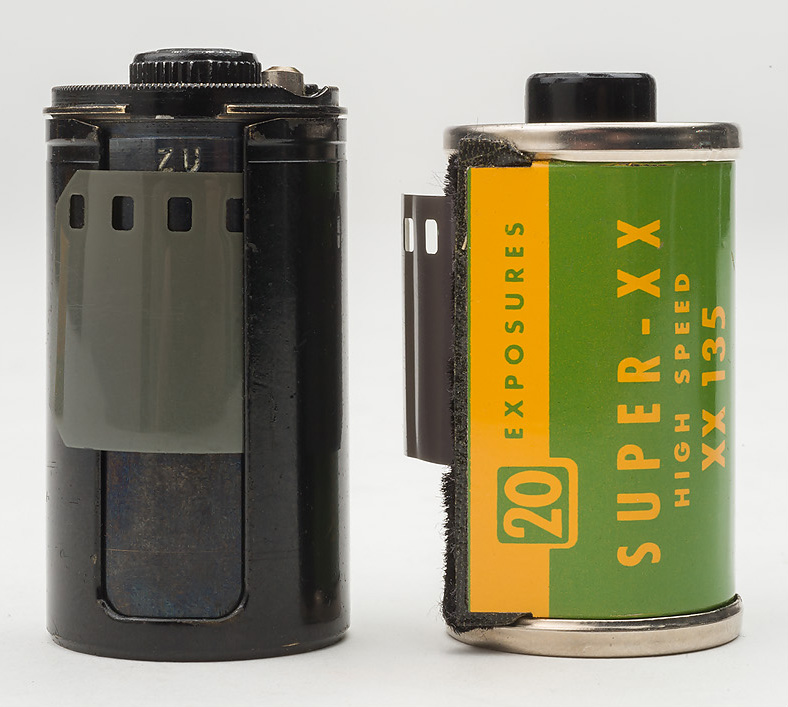
A Zeiss Ikon reloadable cassette is shown next to Kodak’s slightly shorter prepackaged cassette. Photo © 2015 by Rob McElroy.
The registration problem didn’t affect only Zeiss Ikon cameras. Leica cameras also had a similar problem, and there are countless examples of sprocket-hole misregistration showing up on 35mm film from other photographers during this time. Here’s a detail showing the same effect, from a 1951 contact sheet by Ruth Orkin that contains her most famous image, “American Girl in Italy” (frames 8-10, detail).

Ruth Orkin contact sheet showing intrusion of image area into sprocket holes, frames 8-10, detail. Images © 1951 Estate of Ruth Orkin.
Leica finally engineered a solution to the registration problem in 1952 by installing a newly designed vertical bar in the baseplate of their new cameras, which now kept the film in the proper position/registration regardless of variations in cassette size. (Older Leica cameras could also be retrofitted with the new bar; see the accompanying ad.) Leica described their solution this way:
“On the baseplate of all recent models is a new vertical bar which has been added to keep film in position while it is being wound through the camera. Previously, there were some cases where the film was out of alignment due to the variation in cartridge tolerances.” (Leica Photography, Winter 1952, Vol. 5, No. 4, p. 27.)
(Note: There are instances where sprocket holes can also become exposed because of improper film loading in cameras such as the Leica M2 and M3, but that cause is different than the one examined here.)
[In Part 2 of this article McElroy provides the precise technical explanation of the sprocket-hole phenomenon, with additional illustrations. — Editor]
•
(Thanks to Tim Fuss of Rochester, NY for his loan of a Contax II camera for the illustrations used in this story, and to Maurice M. Greeson of Syracuse, UT for his gift of the Zeiss Ikon cassette. Thanks also to A. D. Coleman and J. Ross Baughman for their helpful advice and suggestions when editing the story.)
Text copyright © Rob McElroy 2015. All photographs © Rob McElroy 2015 unless otherwise noted. All rights reserved.
•
(For an index of links to all posts in this series, click here.)
•
Based in Buffalo, NY, Rob McElroy has been a professional photographer since 1980, shooting primarily photojournalistic, commercial, advertising and magazine assignments. He has extensive experience and thrives on photographic challenges both technical and artistic. In his early years he honed his skills working full time for the Associated Press and shooting sports for the NFL, all the while continuing to shoot industrial, commercial and studio jobs to get experience in all of photography’s genres.
For the past 15 years, McElroy has turned his attention to mastering the art of the daguerreotype process, and he is one of only a handful of practicing daguerreotypists. For a Flickr portfolio of his daguerreotypes, click here. Click here for a 2009 interview with him about his daguerreian activities.
He’s also a photo historian, having researched and co-written two books on local photo history. His extensive photo-history library, along with his large study collection of early photographic materials, keeps him actively involved in photo-conservation research projects, often in collaboration with various institutions. To contact Rob McElroy, click here.


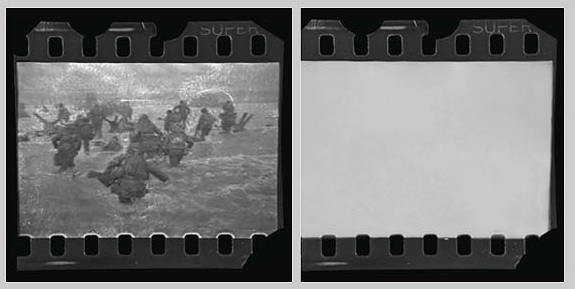
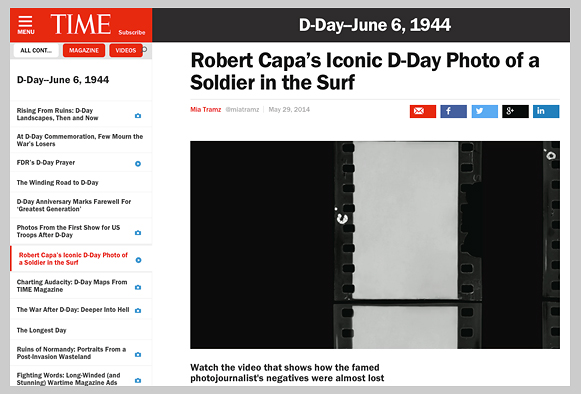
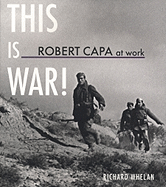
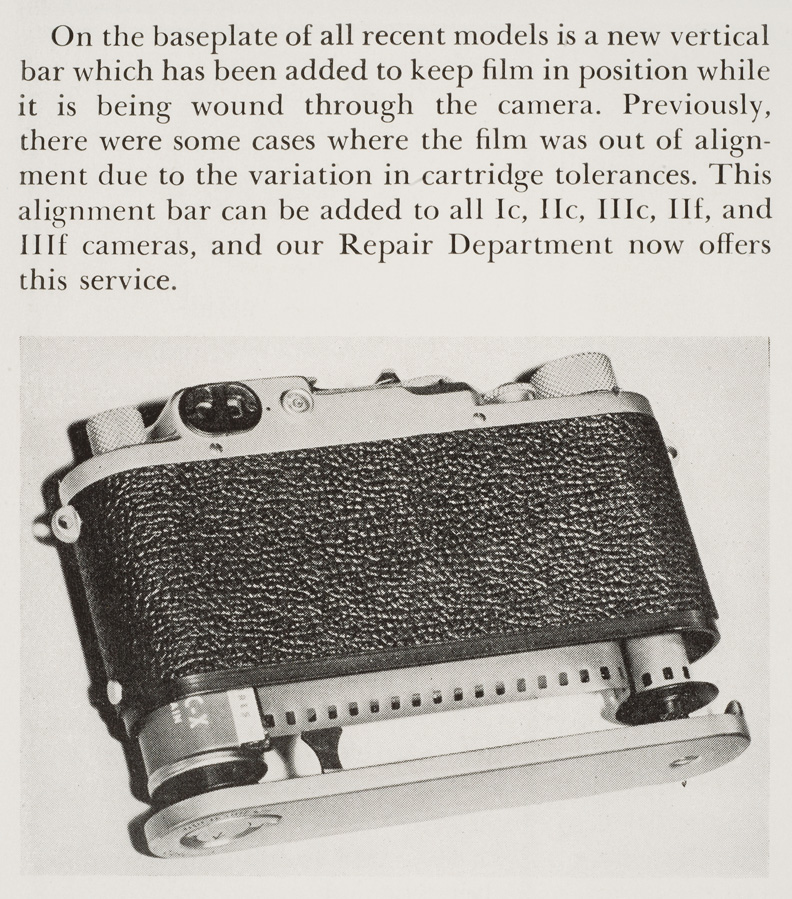





Allan,
Ever since I had a hard time identifying where my parents lived when I was born, I have been constantly amazed at how quickly history disappears. I have always wondered why 35mm film was marked “135”. Now I know.
As if there needed to be yet more proof that the Capa story was fabricated.
Best,
Chuck
Way to go Rob!
Glad to have played my part in infecting you with the daguerreotype process.
This research and writing about the Capa negatives is a withering condemnation of people that don’t take the time to understand what they are looking at or talking about, or if they do or did, perpetuating and expanding a serious fabrication. IMHO there is no one like you to do this work to expose a fraud foisted upon 3/4 of a century of the history of photography. You are Spot-On, with completely independent confirmation. (And I will claim to know a bit about photographic technology.)
Carry on, friend!
Ken Nelson